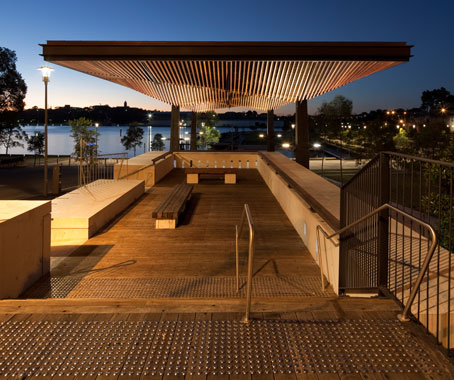
A new park on Sydney’s former Water Police site reconnects the area to the waterfront.
Harris Street, Pyrmont is now reconnected with the waterfront for the first time in over a hundred years.
Story continues below advertisement
Pirrama Park, with its dramatic corner café and waterside plaza, anchors the street to Elizabeth Macarthur Bay, replacing various industrial uses that previously dominated the site and made it inaccessible to the public.
ASPECT Studios together with Hill Thalis Architecture + Urban Projects and CAB Consulting prepared the master plan and design for the City of Sydney Council.
Story continues below advertisement
The design teams were faced with a vast, concrete platform and wharves remaining from the activities of the site’s former occupant, the Water Police.
Story continues below advertisement
The opportunity to reconnect Harris Street with the harbour was a unanimous response to the site by the design teams.
This opportunity was developed through three design principles: the flexible park, the richness and variety of the park experience, and engaging with water.
ASPECT coordinated the park’s design with Hill Thalis focusing on the architectural elements of the project.
Essentially, the park’s form is focused on two spines – a water promenade defined by an edge suggestive of the former shoreline, and Harris Street, which is terminated by the plaza, canopy and belvedere.
The multi-purpose park spine runs north-south through the site and is formed from a walkway, a low, straight retaining wall edged with a parallel planting bed and irregular concrete walls reminiscent of the former shoreline.
As with many elements of the site, the retaining wall integrates multiple functions.
There are several water rooms on the harbour side of the wall – the inlet and pole garden – while on the landward side there are gum groves, playgrounds and lawn areas.
There is a design vocabulary of robust and brutalist elements that reference the past industrial use of the site and the relationship between the park’s elements.
There is a complex and thorough logic and process behind the design of the building, where all the elements, materials and functions are interrelated in a poetic manner.
“The Canopy provides generous shade and shelter to the elements, and becomes the architectural symbol of the park,” says Thalis.
It is a symbol that has already caught the imagination of park users in how they use every aspect of the building and has opened the park up to its future.
Tempe Macgowan is a landscape architect and freelance writer on landscape architecture.